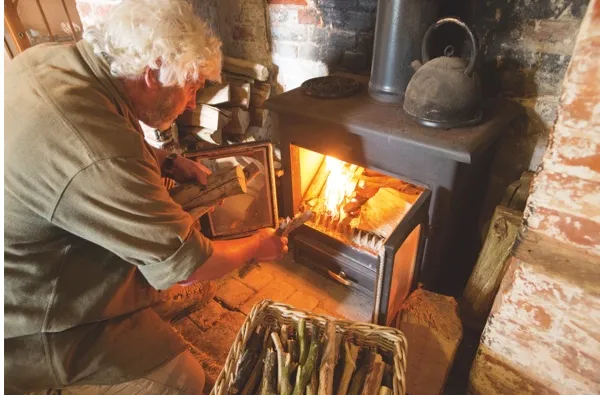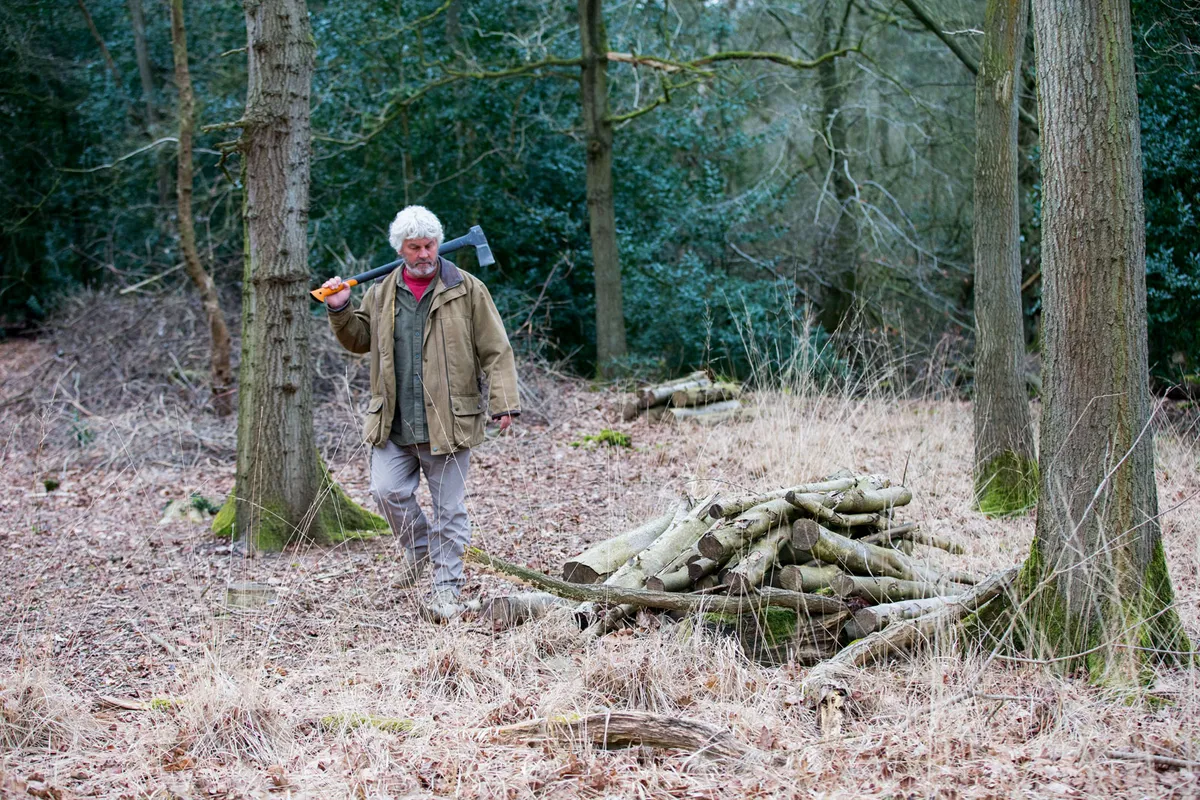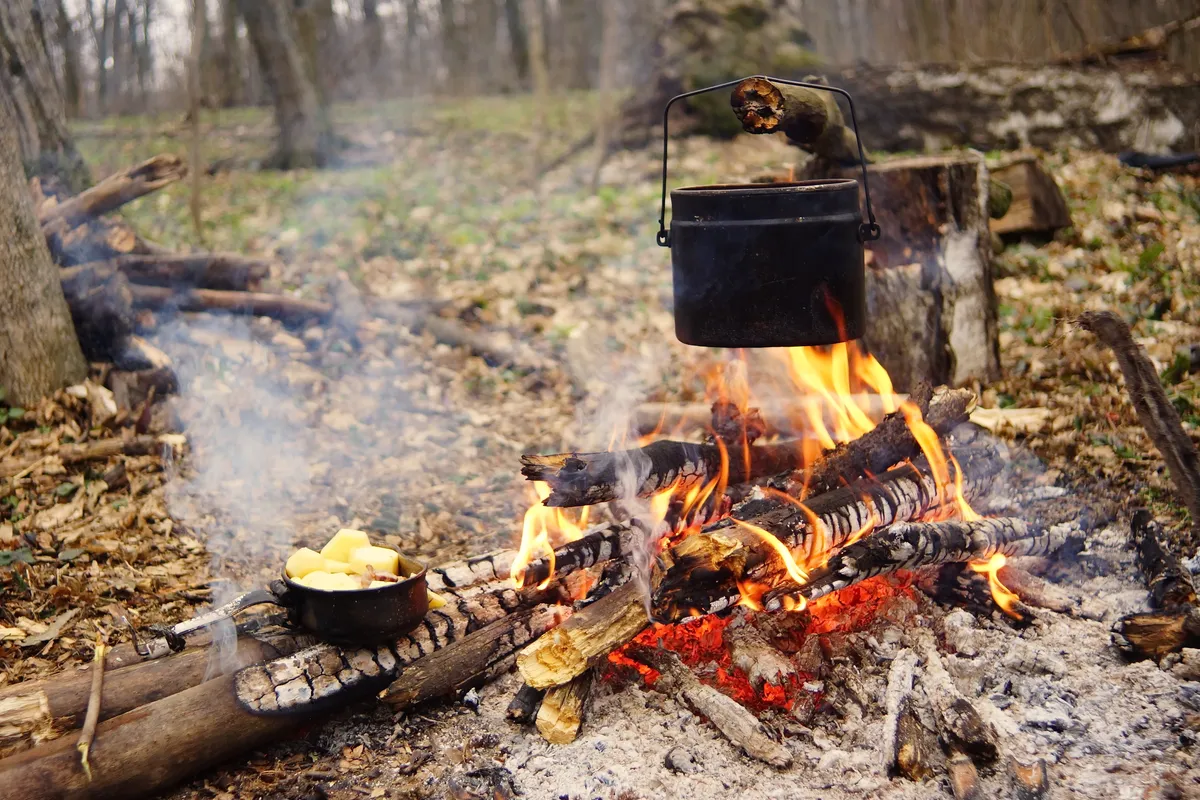As each winter approaches, rising energy prices seem to hit the headlines. So it's not surprising that some turn to firewood as an occasional heating source. But with recent data (updated in February 2024) finding domestic coal and wood burning to be one of the biggest sources of small particulate air pollution in the UK (PM2.5), it's more important than ever to ensure you're burning the right kind of wood. Our expert guide gives you the low-down on what constitutes the 'right' type of wood – whether you buy or collect it – as well as the best way to store and season wood.
Naturally, this is the time of year when we become a little competitive with our fire-lighting skills, with everyone having their own methods – whether that's holding a newspaper across the hearth to force the pull from the chimney, or building a traditional pyramid in the grate. If your skills are a little rusty, see below for how to light the perfect fire – and settle that argument once and for all.

What fuel can I burn at home?
• By law, all firewood should contain less than 20% of moisture, which generates smoke. This is no bad thing: properly seasoned wood burns hotter and cleaner. If buying in, look for Woodsure’s Ready to Burn logo:

If seasoning your own wood, use a moisture meter.
• Buy sustainably sourced firewood from woodlands where new trees constantly replace harvested ones. Look for FSC certification or Confor’s ‘Grown in Britain’ labels.
• To keep particulate pollution levels down, burn smaller logs – large ones can end up smouldering at lower temperatures, releasing more harmful molecules. Start your fire with kindling, then add pieces of wood around 5–8cm wide. When these are burning well, add medium-sized logs (roughly 8–12cm).
• See Defra’s advice on responsible burning for more information on safely burning fuel.

How to burn wood safely and sustainably
The Stove
• First, consider whether burning wood is appropriate for your home. The Centre for Alternative Technology offers more information on this.
• Make sure your home is as energy efficient as possible. This will allow you to choose a smaller burner, using less fuel.
• Choose accredited wood stoves or pellet boilers – look for the HETAS Ecodesign Compliant label:

• Batch boilers (which burn a batch of wood and release heat slowly) and pellet boilers are most efficient. Pellet boilers convert about 90% of energy into useful heat. Wood stoves absorb heat, then radiate it into your room. By contrast, most heat from open fires disappears up the chimney, and almost all stoves with back boilers don’t meet smoke-control standards.
• Burn hot: use the vents on your stove to keep air flowing in, and the fire hot. Don’t close them to smoulder wood at a low temperature (also known as ‘slumbering’ – keeping a stove smouldering overnight), which produces extra smoke and particulate pollutants.
• Use a stovepipe thermometer to check you are burning your wood at the correct temperature.
• Keep your stovepipe clean.
What is the best way to light a fire?
There is nothing quite as satisfying as being the one who gets the log fire blazing first time. Here is a step-by-step how to create the perfect log fire in five simple steps.

1. Get an ample supply of fully-seasoned firewood logs
Pick a range of different sized logs (up to 8-12cm wide), with a moisture content of less than 20%. Fill the wood basket in daylight to save going out to the woodshed after dark and remember that an open fire will burn around five times more than a wood-burning stove.
2. Good kindling is essential
Keep a small basket of dry sticks split to 1-2 cm diameter. These can be supplemented by fallen sticks and branch wood gathered during country walks – beech sticks are best. Pine cones and dried orange peel are also really good kindling.
3. Don't clear the grate completely
Leave a blanket of ash 3–5 cm deep and make a slight saucer-sized depression in the middle where the kindling will go. The ash is brilliant at holding the very first embers and will help the fire to get going more quickly – it will also protect the inside of the wood stove, prolonging its life.
4. Create an enclosure for the fire
Place a large log to the back of the fire and a smaller log to the left and right of the fire. You now have a log lined enclosure to light the fire, with an ash base. Place the material you will first light, rolled up paper, shreds of cardboard or a tiny piece of firelighter, in this space and arrange several sticks of kindling on top. Have a couple of small split logs, say 5-10cm diameter, ready to place on top of the kindling once you are sure it has lit. With a wood stove, have all the air vents open at this stage, and maybe the door just slightly open.
5. Warm the chimney
The trick is to get the fire burning really well for 30 – 45 minutes to warm the chimney. Get the stove up to working temperature – about 200°C if you have a stove thermometer. Then partly close the stove air vents, so that you have beautiful rolling flames above the fire. Feed your fire one or two fresh logs when the burning logs are half embers. Keeping the fire ‘low’, that is burning just enough wood to keep the stove running efficiently, is an art, but worth learning as it is the secret to an easy life of perfect fires.

What is the impact of wood-burning on the environment?
Recent data (updated in February 2024) has shown that domestic combustion (which covers households burning a variety of fuels including wood, coal, solid smokeless fuels, and fuels derived from waste such as coffee logs) was a major source of small particulate air pollution in the UK (PM2.5 and PM10). Most emissions from this source came from households burning wood in stoves and open fires.
Regulations were introduced in May 2021 banning the sale of wet wood (that which has more than 20% moisture content), bagged traditional house coal and wet wood in units under 2m3, and solid fuel with high sulphur content.
These restrictions were part of the Conservative government's Clean Air Strategy of January 2019, a series of measures to improve the air quality within the UK.
How is firewood processed?
There are two ways of processing fresh timber – or ‘wet wood’ – into firewood that is dry enough to burn with minimal air pollution. You can season it in a well-ventilated stack for two years (or till the moisture content drops to 20%). Or you can speed up the process by kiln-drying. Here, logs are cut into firewood by machines and loaded into ‘kilns’ – modified skips with perforated floors. Hot air, created by a 950kw woodchip boiler working 24/7, is blown into the bottom of the skips and rises through the perforated floors to dry the wood.
Which is the best type of wood to burn?

Kilo for kilo, all firewood types have a similar heat value, but when it comes to scent, crackle and flame, there is a lot to learn. We asked Vincent Thurkettle for his top tips.
1. Beech
'A dense wood which takes 1 year to season. Bright yellow flames, good embers, long hot burn, rarely throws sparks. Gentle smoke with scent of fresh-cut hay. My first choice.'
2. Oak
'Dense logs, can take two years to season. Very good embers, reasonable flames, crackles, rarely throws sparks. Best used in mixture. Fierce, eye-watering smoke, but a hint of smoke suggests mulled wine or cloves to me.'
- Oak tree guide: how long they take to grow, UK species and how to identify?
- Hawthorn tree guide: berry, blossom and why it's called the May tree
- Silver birch guide: the "most beautiful of forest trees – the Lady of the woods"
3. Elm
'Ridiculed in firewood poems but an excellent firewood. Long-seasoning. Dense, hard to split, poor flames, but first-rate embers. Smoke is sharp but fruity.'
4. Hawthorn
'Beautiful logs, but it is hard to get hold of. Seasons in a year, good flame, excellent embers, rarely throws sparks and has a thin sweet-scented smoke.'
5. Fruitwoods (apple, cherry, plum)
'Dense, delightful firewood. Bright flames, good embers, seasons within the year. The smoke is floral and sweet-scented.'
6. Ash
'Medium density, easy to split, naturally low moisture content, seasons rapidly. Pale ethereal flames, moderate embers. Produces soft, vanilla-scented smoke.'
7. Birch
'Medium density, easy to split, seasons rapidly. Good flames, moderate embers, rarely throws sparks. Bark makes great natural firelighters. Smoke is aromatic.'
8. Scots pine
'Best for kindling. Low-density, resinous, catches easily – important when building a ‘top-down’ fire.'
How to store and season your firewood
As winter bites, it feels good to have a store full of well-seasoned logs and know that, whatever nature or the modern world throws at you – in storms, power cuts or shortages – your home will be warm. But you need to be sure you have enough wood of the right quality. Knowing how much to buy in is a matter of judgement and depends on how much space you have to store your logs.

The importance of seasoning cannot be overstated. Logs dried out to a moisture content of between 15–25% are said to be fully seasoned. You can check this with a moisture meter – readily available and easy to use.
Drying is very important because it takes a lot of heat energy to boil off the moisture in wood – energy that should instead be heating your home. Ash logs will burn when freshly felled but have a moisture content of about 35%: so a kilo of fresh ash logs contains roughly 0.35 litre of watery sap, a little over half a pint. Just visualise the heat needed to boil this water away in a saucepan – what a waste.
Checklist for buying firewood
1. Are the logs being sold by weight or volume – if by volume, are they stacked or loose?
2. What is the size range of the logs and are they split?
3. Are they hardwood, softwood or a mixture of the two?
4. Are the logs seasoned, or ‘green’? The latter won’t burn efficiently.
5. How will the logs be delivered?
6. Is there a discount for bulk loads or for green logs?
7. Do the logs come from a sustainable source?
8. Finally… what is the price?

Can you gather wood in the wild?
Most woodland managers would not object to a family gathering a few kindling sticks or pine cones while out walking, but if someone is filling their car with roadside wood, the manager’s approach will be rather different. Foresters often store felled wood at the roadside, perhaps for months – it is not waste, nor forgotten.

Firewood can be gathered from less obvious places, such as beach driftwood or sawn waste in skips. A huge amount of waste wood ends up in landfill. The Government decided against banning this practice in 2013 and many skips still contain a proportion of good firewood. Again, the rule is to ask the owner, but this time it is also important to ensure that any wood recovered is free of paint, preservatives or pesticides – if there is any doubt, don’t burn it. Salt-laden driftwood is also to be treated with care. The occasional piece is fine, but be aware that you are introducing highly corrosive sea salt into your metal wood stove and chimney system.
What is the history of the wood fire?
Evidence is growing that we had fire long before we were actually human. Many anthropologists now believe that it was almost two million years ago that our early hominid ancestors first learned to tame wild fire, to domesticate it and reap the rewards of light, warmth, protection and cooked food. Curiously, it is the last of these benefits that provides the best evidence.
While early hearth sites have been studied by archaeologists, centuries of wind and rain have caused most to melt back into the environment and become indistinguishable from the burnt remains of natural fires. The further we go back, the harder it is to say whether a slight hollow with scorched earth and charcoal fragments is a hearth or simply the remains of a burnt-out tree stump.
The physical evidence for very early, deliberate fire sites is sparse and often tenuous and many scientists now believe that the best evidence for the earliest use of fire is in fact not the hearth sites at all – rather, it’s us, the human mind and body.
- Best hot water bottles to keep you warm on winter evenings
- Best fire pits for creating a cosy atmosphere
We have small mouths and teeth and a short digestive tract when compared to the other primates. It seems that our bodies may have physically adapted to consume cooked food. Cooking meat and plants breaks down starch and proteins, making it easier to absorb the food energy. This pre-digestion of our raw food through cooking allows the day’s energy requirement to be absorbed much more quickly. It’s been calculated that a human would need to eat for 9.3 hours a day if all of the day’s food was eaten raw and unprocessed. Researchers have observed that non-human primates spend an average of 48% of their day eating, compared to only 4.7% for humans.
These differences in our body’s digestive system are strong evidence of an unimaginably long relationship with cooked food and the curious phenomenon of fire.

But it is not just a physical adaptation: we are mentally different, too. Even today, people tend to sit around a campfire in a circle – which is fun, but not important. But just imagine the effect on our nascent social development to sit and face each other for hours each evening. The mastery of fire had lengthened our day; sunset no longer heralded a time of predators and fear, darkness no longer held dominion – and our species blossomed.
Fire was staggeringly important to the development of modern humans and even today has an essential role in our lives – we still delight in the joy, warmth and self-sufficiency that a full woodshed promises as the nights draw in and winter arrives.
Vincent Thurkettle is a woodsman who grows Christmas trees and also prospects for gold. He is author of The Wood Fire Handbook (Mitchell Beazley, 2012)
